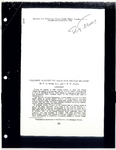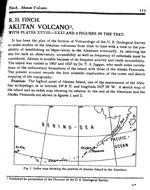Akutan 1949/4
Start: April 29, 1949 [1]
Stop: June 1949 ± 3 Months [1]
Event Type: Explosive
Max VEI: 2 [2]
- Lahar, debris-flow, or mudflow [1]
Description: Unknown (Earth Science Digest, 1949) reports: "* * * According to Hugh McGlashan, postmaster at Akutan, a village 8 miles east of the volcano, 1/8 inch of ash fell on the village during the night of April 29. Ash mixed with sleet continued to fall all during the following day because of a steady west wind from the direction of the volcano. Now snow on the higher slopes of the volcano is covered by a heavy black layer of ash. The eruption continued full scale until May 10 and then decreased somewhat in intensity.
"On May 17 several of the villagers made a closer approach to the volcano and reported hot lava flowing down the northwest slope. Considerable steam was rising at the front of the lava where it encountered the winter blanket of snow. This material may have been a hot mudflow, formed by lava mixing with snow, ice, and boulders inside the crater.
"* * * * Approximately two weeks prior to the recent eruption, three heavy earthquakes were felt at the village."
From Byers and Barth (1953): "The clatter of falling rock was perhaps what had been heard by local residents as a "crackling roar" (Finch, 1935, p. 159) during the 1929 eruption.
"Within a minute after the first discharge, a dark grey cauliflower-shaped cloud extending nearly a mile above the cone could be seen on a clear day. This cloud was soon dissipated by the wind. Frequently, the blasts were sharp enough to be termed explosions, and then resembled quarry blasts. Some of the explosions were loud enough to be heard at Akutan village, 8 miles distant.
"Smaller puffs of lighter grey, ash-laden clouds [see fig. 5 in original text] occurred between major blasts at intervals ranging from a few minutes to a few hours. Usually, several smaller puffs followed a major blast." A block ejected during this time period was analyzed in thin section and found to be saturated calcic basalt.
"On May 17 several of the villagers made a closer approach to the volcano and reported hot lava flowing down the northwest slope. Considerable steam was rising at the front of the lava where it encountered the winter blanket of snow. This material may have been a hot mudflow, formed by lava mixing with snow, ice, and boulders inside the crater.
"* * * * Approximately two weeks prior to the recent eruption, three heavy earthquakes were felt at the village."
From Byers and Barth (1953): "The clatter of falling rock was perhaps what had been heard by local residents as a "crackling roar" (Finch, 1935, p. 159) during the 1929 eruption.
"Within a minute after the first discharge, a dark grey cauliflower-shaped cloud extending nearly a mile above the cone could be seen on a clear day. This cloud was soon dissipated by the wind. Frequently, the blasts were sharp enough to be termed explosions, and then resembled quarry blasts. Some of the explosions were loud enough to be heard at Akutan village, 8 miles distant.
"Smaller puffs of lighter grey, ash-laden clouds [see fig. 5 in original text] occurred between major blasts at intervals ranging from a few minutes to a few hours. Usually, several smaller puffs followed a major blast." A block ejected during this time period was analyzed in thin section and found to be saturated calcic basalt.
References Cited
[1] Aleutian volcano erupts [Akutan Volcano], 1949
Unknown, 1949, Aleutian volcano erupts [Akutan Volcano]: Earth Science Digest, v. 3, n. 11, p. 13.[2] Volcanoes of the world [2nd edition], 1994
Simkin, Tom, and Siebert, Lee, 1994, Volcanoes of the world [2nd edition]: Tucson, Arizona, Geoscience Press, 349 p.[3] Volcanic activity in the Aleutian Arc, 1950
Coats, R. R., 1950, Volcanic activity in the Aleutian Arc: U.S. Geological Survey Bulletin 0974-B, p. 35-49, 1 sheet, scale 1:5,000,000.[4] Uebersicht ueber die vulkanische Taetigkeit 1948-1950, 1955
Hantke, Gustav, 1955, Uebersicht ueber die vulkanische Taetigkeit 1948-1950: Bulletin Volcanlogique, v. 14, p. 151-184.[5] Volcanic activity on Akun and Akutan Islands, 1953
Byers, F. M., and Barth, T. F. W., 1953, Volcanic activity on Akun and Akutan Islands: in Pacific Science Congress, 7, Proceedings, v. 2, New Zealand, 1949, Geology, p. 382-397.[6] Aleutian volcano acting up again, 1949
Associated Press, 1949, Aleutian volcano acting up again: The Austin Statesman, Austin, TX, May 27, 1949, p. 9.[7] Volcano again emits lava in north islands, eruption recalls earlier action in Aleutians, 1949
Unknown, 1949, Volcano again emits lava in north islands, eruption recalls earlier action in Aleutians: Nevada Mining Journal, Reno, NV, June 2, 1949, p. 9.Complete Eruption References
Aleutian volcano erupts [Akutan Volcano], 1949
Unknown, 1949, Aleutian volcano erupts [Akutan Volcano]: Earth Science Digest, v. 3, n. 11, p. 13.
Hard Copy held by AVO at FBKS - CEC file cabinet
Volcanic activity on Akun and Akutan Islands, 1953
Byers, F. M., and Barth, T. F. W., 1953, Volcanic activity on Akun and Akutan Islands: in Pacific Science Congress, 7, Proceedings, v. 2, New Zealand, 1949, Geology, p. 382-397.

Volcanic activity in the Aleutian Arc, 1950
Coats, R. R., 1950, Volcanic activity in the Aleutian Arc: U.S. Geological Survey Bulletin 0974-B, p. 35-49, 1 sheet, scale 1:5,000,000.

Volcanoes of the world [2nd edition], 1994
Simkin, Tom, and Siebert, Lee, 1994, Volcanoes of the world [2nd edition]: Tucson, Arizona, Geoscience Press, 349 p.
Hard Copy held by AVO at FBKS - CEC shelf
Aleutian volcano acting up again, 1949
Associated Press, 1949, Aleutian volcano acting up again: The Austin Statesman, Austin, TX, May 27, 1949, p. 9.
Hard Copy held by AVO at FBKS - CEC file cabinet
Volcano again emits lava in north islands, eruption recalls earlier action in Aleutians, 1949
Unknown, 1949, Volcano again emits lava in north islands, eruption recalls earlier action in Aleutians: Nevada Mining Journal, Reno, NV, June 2, 1949, p. 9.
Hard Copy held by AVO at FBKS - CEC file cabinet
Akutan volcano, 1935
Finch, R. H., 1935, Akutan volcano: Zeitschrift fuer Vulkanologie, v. 16, n. 3, p. 155-160, 4 plates, scale unknown.
